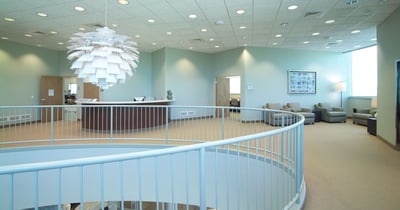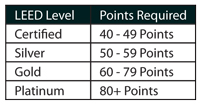
Determining If the Cost Will Be Offset by the Benefits
The breakdown of advantages vs. disadvantages for LEED© certifying your medical office is easy – it’s energy cost savings, environmental responsibility, plus marketing position (to name a few) vs. cost.
 While it’s quite hard to pinpoint what the additional cost truly is over traditional construction, a quick internet search indicates that building owners could pay an additional 0-15% for a sustainable building. The additional cost depends primarily on the level of certification you’d like to achieve because the higher the level of the United States Green Building Council (USGBC) point rating system the more green materials and equipment you need, which usually have an elevated cost. There are some points that have no cost, like having a bus stop near your building (6 points), and there are others, like installing a geothermal system (1-7 points) that adds considerable cost. These are both options on a list of points available to achieve your preferred level of certification whether it’s certified, silver, gold or platinum with platinum requiring the most points.
While it’s quite hard to pinpoint what the additional cost truly is over traditional construction, a quick internet search indicates that building owners could pay an additional 0-15% for a sustainable building. The additional cost depends primarily on the level of certification you’d like to achieve because the higher the level of the United States Green Building Council (USGBC) point rating system the more green materials and equipment you need, which usually have an elevated cost. There are some points that have no cost, like having a bus stop near your building (6 points), and there are others, like installing a geothermal system (1-7 points) that adds considerable cost. These are both options on a list of points available to achieve your preferred level of certification whether it’s certified, silver, gold or platinum with platinum requiring the most points.
The advantages are more concrete to determine. For instance, there are marketing opportunities and a general buzz associated with having a LEED© certified building and it can attract patients who are interested in green building or sustainability. Also, since most buildings (medical offices included) carry their highest energy costs from space heating/cooling and lighting, the use of efficient equipment can save significant costs over the life of a building (1-19+ points). The final benefit that I’ll discuss here is the use of natural light (1 point). Natural light not only improves mood and general well being of the doctor, staff and patients, but it also improves vision (less eye strain), productivity of staff, and offers health benefits all on its own – definitely an important feature in a medical space.
You may have heard that the USGBC has published a LEED© for Healthcare rating system, specifically for hospitals and other medical facilities to achieve LEED© while addressing stringent healthcare industry regulations. This new rating system may require more prerequisites than you need to prepare your medical office. I say this because it’s geared more to a hospital’s 24 hour operation and indoor environmental quality associated with chemicals used on the premises. It would likely be less expensive for a medical office to use the LEED© for New Building or LEED© for Existing Buildings: Operation & Maintenance.
If you are interested in pursuing it, Wolgast has a team of LEED© Associated Professionals (LEED© APs) on staff and they’ve been trained to help you review the rating systems and develop a list of points that will suit you best as well as design and construct the building. Contact Dr. Michael Shepard for more information at mshepard@wolgast.com or 989-790-9120.
Sources used:
www.usgbc.org

